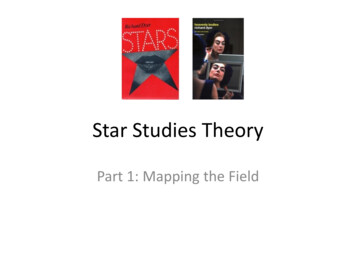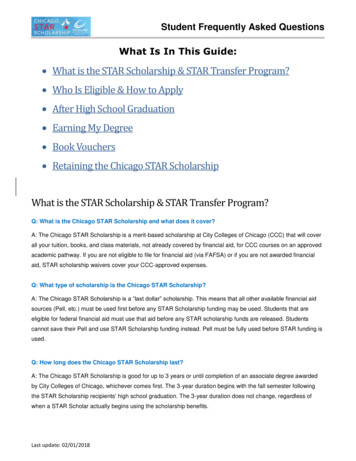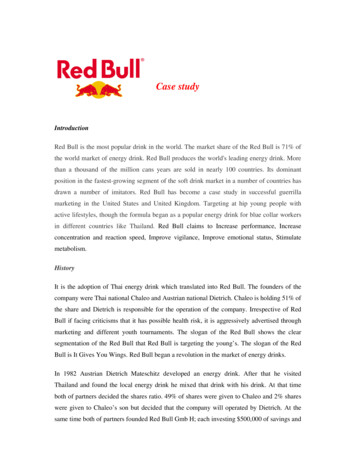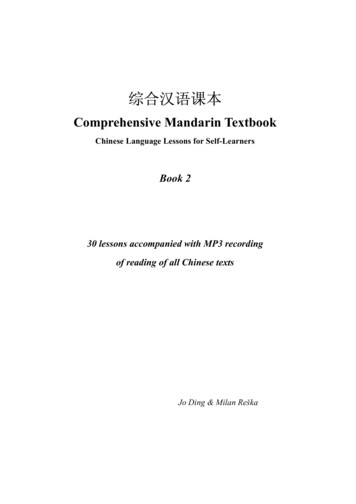
Transcription
Star Studies TheoryPart 1: Mapping the Field
Introduction This lecture will map out the field of starstudies and identify the most influential worksassociated with it. Discuss Richard Dyer’s work (Stars, 1979). Discuss the earlier studies that influenced Dyer’swork on stars. Consider how scholars have subsequently developedand departed from Dyer’s work.
Richard Dyer’s Stars (1979) In 1991, Christine Gledhill noted that Dyer’s bookhad “laid the groundwork for star analysis within filmstudies” (Gledhill, Stardom: Industry of Desire, 1991: xiv). In 2000, Ginette Vincendeau wrote that Dyer had,“single-handedly created ‘star studies’” (Vincendeau,Stars and Stardom in French Cinema, 2000: Preface, x). In 2006, Karen Hollinger wrote that Dyer’s studyprecipitated a “seismic shift in the way in which starstudies were perceived” (Hollinger, The Actress, 2006: 35).
Richard Dyer’s Stars (1979) Dyer’s book combined semiotics andsociology, introducing the notion of the ‘startext’ – an intellectual construct producedacross a range of media and cultural practices(only partly films). The star text also included promotionalmaterial and publicity.
Richard Dyer’s Heavenly Bodies (1986) This book extended and deepened the natureof his earlier work through its case studyanalysis of three major stars: Marilyn Monroe,Paul Robeson and Judy Garland. It also placed more emphasis on audiencesand how stars mean different things todifferent kinds of audience.
Star Studies before Stars Roland Barthes, Mythologies (1957) Edgar Morin, Les Stars (originally published inFrench in 1957 and translated into English byRichard Howard for the University of MinnesotaPress in 2005). ‘the star straddles both sacred and profane, divineand real, aesthetic and magic, like the kings’(Morin, 1957/2005: 84)’ The star is a sacred monster: one born from aconjunction of capitalism, modernity and themythology of love (p. 147).
From Les Stars to Stars In the conclusion to Stars, Dyer calls his ownbook, “a survey of what has been done in thestudy of stars and what needs to be done”(Richard Dyer, 1979: 160).
The structure of Dyer’s Stars Three parts:– Part 1 is sociological and entitled ‘stars as a socialphenomenon’– Part 2 is sociological and semiotic, entitled ‘stars asimages’– Part 3 is semiotic and entitled ‘stars as signs’ Texts are considered as “social facts,” Dyerreasoning that, “textual assumptions must begrounded in sociological ones” (Dyer, 1979: 1). Therefore, the fundamental (or foundational)concept running throughout the book is ideology.
Structured Polysemy ‘From the perspective of ideology, analyses of stars – asimages existing in films and other media texts – stresstheir structured polysemy, that is, the finitemultiplicity of meanings and affects they embody andthe attempt so to structure them that some meaningsand affects are foregrounded and others are masked ordisplaced. The concern of such textual analysis is thennot to determine the correct meaning and affect, butrather to determine what meanings and affects canlegitimately be read in them. How these are in factappropriated or read by members of different classes,genders, races, etc. is beyond the scope of textualanalysis (although various conceptualisations of thiswill be found throughout the book)’ (Dyer, 1979: 3).[Emphasis mine]
Economics and more ‘The enormous economic importance of stars,the elaborate machinery of image-building andfilm’s importance in establishing character-typesall suggest the potential power of the forces ofcinematic production for creating the starphenomenon. However, these explanations ofthe star phenomenon are not sufficient inthemselves and we need to see the phenomenonin its cultural, historical and ideological context tounderstand where the producers’ ideas andimages of stardom and of specific starsthemselves come from’ (Dyer, 1979: 17).
Audience-star relations Dyer defines four aspects to is:– emotional affinity– self-identification– Imitation– projection
Ordinary & Special Qualities ‘One of the problems in coming to grips withthe phenomenon of stardom is the extremeambiguity/contradiction concerning thestars-as-ordinary and the stars-as-special. Arethey just like you and me, or do consumptionand success transform them into (or reflect)something different?’ (Dyer, 1979: 43)
The Paradox ‘The paradox of the extravagant lifestyle and success ofthe stars being perceived as ordinary may be explainedin several ways. First, stars can be seen as ordinarypeople who live more expensively than the rest of usbut are not essentially transformed by this. Second,the wealth and success of the stars can be seen asserving to isolate certain human qualities (the qualitiesthey stand for) without the representation of thosequalities being muddied by material considerations orproblems. Both of these explanations fit with notionsthat human attributes exist independently of materialcircumstances. Stars may serve to legitimate suchnotions’ (Dyer, 1979: 43).
Types & Individuals Dyer points out that, ‘stars relate to thesocial types of a society’ and also that the ‘starboth fulfils/incarnates the type and, by virtueof her/his idiosyncrasies, individuates it’ (Dyer,1979: 47). ‘Stars embody social types but star images arealways more complex and specific than types.Types are, as it were, the ground on which aparticular star’s image is constructed’ (Dyer,1979: 60).
Analyzing Star discourses Plethora of star texts across the various regimes of promotion,publicity, films and criticisms and commentaries. Emphasis on textual analysis Film texts read as star vehicles ‘Films were often built around star images. Stories might bewritten expressly to feature a given star, or books might bebought for production with a star in mind. Sometimesalterations to the story might be effected in order to preservethe star’s image. This is what is implied in the term “starvehicle” (a term actually used by Hollywood itself)’ (Dyer, 1979:62).
Analyzing extra-cinematic materials Criticism and commentaries. ‘This refers to what is said or written about the star interms of appreciation or interpretation by critics andwriters. It covers contemporary and subsequentwritings (including obituaries and other materialwritten after a star’s death or retirement), and is foundin film reviews, books on films . To this can be addedfilm, radio and television profiles of stars. These alwaysappear after the initial promotion and film-making of astar, although they may act back on subsequentpromotion and film activity ’ (Dyer, 1979: 62).
Analyzing Performance In Part 3 of Stars, the focus is on acting andperformance (including characterization). This includes how audience identify with characters onscreen. Dyer identifies three distinct modes of star-characterrelationship:– selective use (i.e. where the characters reveals aspects ofthe star’s image while ignoring offer aspects)– perfect fit (i.e. where the star’s image fits with all the traitsof a character, e.g. Clark Gable as Rhett Butler)– problematic fit (i.e. where the star’s image conflicts withthe character they are playing, e.g. Bette Davis as CharlotteVale) (see Dyer, 1979: 125-29).
Analyzing the fit ‘What analysis is concerned to do is both todiscover the nature of the fit between star andimage and character, and, where the fit is notperfect or selective, to work out where thecontradictions are articulated and toattempt to see what possible sources of“masking” or “pseudo-unification” the filmoffers (such as the irresistible unifying force ofa star image)’ (Dyer, 1979: 131).
Analyzing Performance Signs ‘any attempt to analyse performance runs up againstthe extreme complexity and ambiguity of performancesigns’ (Dyer, 1979: 133). ‘The signs of performance are: facial expression;voice; gesture (principally of hands and arms, but alsoof any limb, e.g. neck, leg); body posture (howsomeone is standing or sitting); body movement(movement of the whole body, including how someonestands up or sits down, how they walk, run, etc.). Ofthese the first is often held to be the most important Yet just as its importance may be the greatest, so too isits ambiguity .’ (Dyer, 1979: 134)
Culture-bound interpretations ‘Our reading of performance signs depends in the firstinstance on our very general knowledge of whatintonation, gesture, eye dilations, etc. mean. Thisknowledge is culture- and history-bound’ (Dyer, 1979: 134) ‘This signification of a given performance sign isdetermined by its place within culturally and historicallyspecific codes. In other words, in terms of film, to readBette Davis’s eye movements or John Wayne’s walk, wecannot refer to a general and universal vocabulary of eyeand walking movements, but to specific vocabularies,specific to the culture and specific within it’ (Dyer, 1979: 135)
A Cultural Studies Approach This is a Cultural Studies approach to analyzingscreen performances. The emphasis is oninterpretation by audiences rather than theintentions of the actors.
Signature Style ‘a star will have a particular performance stylethat through its familiarity will inform theperformance s/he gives in any particular film.The specific repertoire of gestures,intonations, etc. that a star establishes over anumber of films carries the meaning of her/hisimage just as much as the ‘inert’ element ofappearance, the particular sound of her/hisvoice or dress style’ (Dyer, 1979: 142).
Challenging the auteur director ‘an important tradition in film theory hastended to deny that performance has anyexpressive value: what you read into theperformer, you read in by virtue of signs otherthan performance signs’ (Dyer, 1979: 143)
Dyer’s Conclusions Four main concluding remarks (pointingtowards where further research would bebeneficial):– (1) The Audience is ‘fundamental to everyassumption one can make about how stars, andfilms, work’ (Dyer, 1979: 160)– (2) Stars can provide insight into ideological crises(introducing the notion of charisma)
Charisma ‘This sense of crisis as to what a person is seems to me tobe central also to the star phenomenon. It can be seen tolie behind star charisma as a generalised phenomenon, inthat stars speak centrally to this crisis and seem to embodyit or to condense it within themselves. How they speak to,embody or condense it may be predominantly in terms ofreaffirming the reality of people as individuals or subjectsover against ideology and history, or else in terms ofexposing precisely the uncertainty and anxiety concerningthe definition of what a person is. Whether affirming orexposing, or moving between the two, stars articulate thiscrisis always through the cultural and historical specificitiesof class, gender, race, sexuality, religion, subculturalformations, etc. Yet all stars seem to me to work at themore general level – itself culturally and historically specific– of defining what a person is’ (Dyer, 1979: 160-61).
Dyer’s Conclusions Four main concluding remarks (pointing towards wherefurther research would be beneficial):– (3) The radical potential of stars for marginalaudiences (reading against the grain) (Dyer, 1979: 162)– (4) Retaining beauty, pleasure and delight whenconducting film analysis/interpretation
Conclusion Stars was not the first sustained academic booklength study of film stars and stardom’ It drew on and synthesized the existing literature onthe topic. It lay the foundations of what would become(certainly by the 1990s) a recognized sub-disciplinaryfield within film studies in terms of concepts, areasof investigation and methodologies, promotinganalysis of stars as texts (films, publicity andpromotion) and as performers/actors and creators ofmeaning.
Richard Dyer [s Stars (1979) Dyer [s book combined semiotics and sociology, introducing the notion of the Zstar text – an intellectual construct produced across a range of media and cultural practices (only partly films). The star text also included promotional material and publicity. Richard Dyer [s Heavenly Bodies (1986) This book extended and deepened the nature of his earlier .











